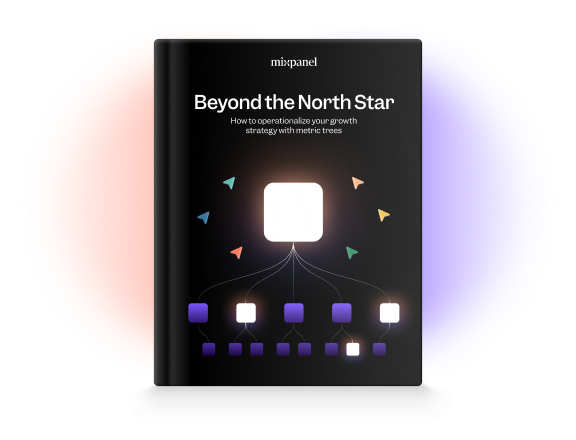Marketing analytics vs. product analytics: Why you need both working together
To be successful, organizations need data. But data is only powerful when unlocked with analysis, and not all analysis types and analysis tools are created equal.
Relative to product analytics, marketing analytics is a well-understood, familiar concept. Many companies already leverage marketing analytics for acquisition growth: identify the marketing channels that are bringing new users to your product and those that aren’t, then double down, fix, or cut those channels.
But sometimes if companies are already exploring data with a marketing analytics tool (typically Google Analytics, though that’s changing—more info on that below), they might think it’s fine to forgo product analytics (like what Mixpanel offers). Or even when they do understand the need for both product and marketing analytics, they reach for disconnected solutions, which can leads to different problems.
Using separate tools for marketing and product analytics can leave gaps in your analysis and a lack of alignment around core metrics across functions. The teams at Mixpanel had their own experience with disjointed analysis across tools, and it's what prompted the push to develop full user journey analytics in Mixpanel, where powerful product and marketing analytics work together in one platform.

Having both product and marketing analytics working together are key, but that doesn’t mean that they’re the same thing. Let’s break down how it all works.
The difference between marketing analytics and product analytics
How marketing analytics works
Marketing analytics solutions are designed to help you understand the first part of the user journey: where users are coming from, and their behavior pre-signup. Marketing analytics tools track metrics like bounce rate and sessions, as well as attribution (where users are coming from).
Pretty much any marketing analytics tool will provide strong reporting on marketing metrics like:
- Number of pageviews
- Sources and attribution for those pageviews
- Time on site
- Completion of goals and transactions
These insights are useful for optimizing marketing efforts and bringing more users to your product. A powerful marketing analytics solution will help you answer questions like:
Which channels are most effective at driving conversions and engagement with your product? How did our recent marketing campaign impact growth? What is our return on ad spend (ROAS), and can it be improved?
It’s important to note that traditional marketing analytics tools were built just for the web, and didn’t always take into account the different ways that users browse and that digital companies build products. More modern, versatile marketing analytics tools will also be designed for things like email analytics and mobile analytics, and use an events-based data model to track user behavior.
How product analytics works
Product analytics solutions provide insights into the next part of the user journey—how people are using the websites and applications product teams build. They offer user segmentation features and reports that can answer questions like:
- Who are your power users? And how do their behaviors differ from other users?
- Why do some users convert, while others don’t?
- How does retention differ by user cohort? Is it higher or lower when people engage with a particular feature?
- What are the top drivers of user engagement and retention?
With a full arsenal of out-of-the-box capabilities like user cohort trends, a powerful segmentation engine, and on-demand deep analysis of user behavior, product analytics solutions give input to product builders. Did that new feature release cause the desired change in behavior? No? Maybe it needs a design tweak.
Product analytics solutions track and report on actions users take within a product, like making a purchase or bookmarking content.
All of this specialization towards deep product usage means solutions like Mixpanel don’t default to only collecting things like pageviews and reporting attribution.
Mixpanel Marketing Analytics vs. Google Analytics 4
The release of Google Analytics 4 has frustrated many longtime users. Between slow load times, mystifying attribution models, and clunky reports, marketers are flocking to alternate solutions.
By contrast, Mixpanel Marketing Analytics, the suite of out-of-the-box marketing metrics and reports in Mixpanel, provides advanced segmentation and flexible funnel and retention reports that make it possible to track conversions at each step, analyze multi-step conversions by segment, and identify funnel drop-offs—all very simply and intuitively.

Unlike in GA4, marketing analytics in Mixpanel is customizable and scalable. Almost as importantly, Mixpanel supports multi-touch attribution, while Google has announced that they are moving towards supporting only last-touch models.
Marketing analytics 🤝 product analytics
Hopefully, it’s clear by now that marketing analytics and product analytics are different—built to serve different teams’ needs and objectives. One can’t replace the other, and in fact, they live in a symbiotic relationship.
When both teams are equipped with the right tools, and when these tools are connected and share a single data source, it creates a cycle of sustainable positive growth for the entire organization. Marketing teams optimize marketing spend to acquire new customers, which gives product teams a larger user base to find new ways to improve engagement, conversion, and retention. Businesses can then identify power users to market to and turn them into vocal advocates, helping fuel the marketing machine. Similarly, they can identify “struggling” users to whom they should offer a different set of product and marketing experiences to reduce churn.
Happy customers, without a doubt, create more happy customers. But it takes both a marketing analytics and a product analytics solution to provide the insights needed to understand the behaviors that drive it.



